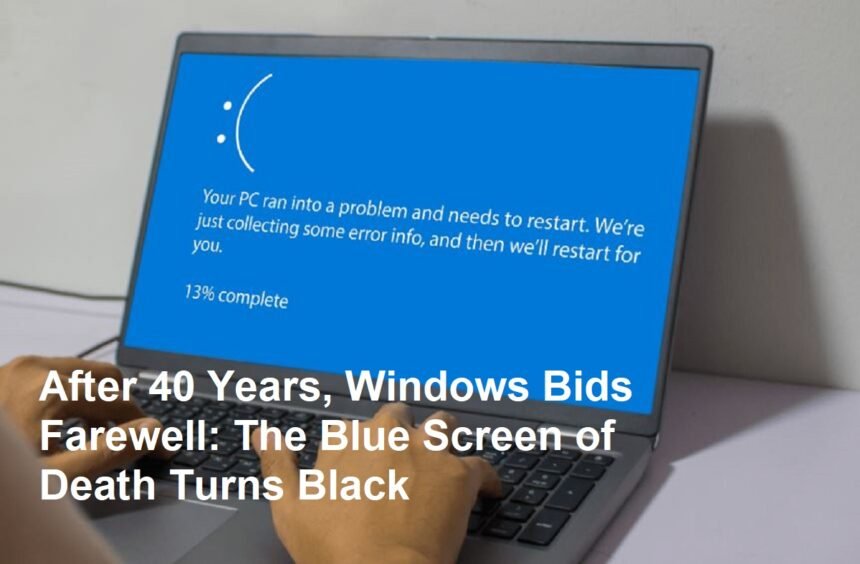Introducing
A defining, if dreaded, icon of the Windows era is undergoing a radical transformation. After an infamous 40-year run, Microsoft has confirmed that the Blue Screen of Death (BSOD) is being replaced by a new Black Screen of Death in future versions of Windows, starting with the upcoming Windows 11 24H2 update. This marks the end of an era for one of computing’s most recognizable symbols of system failure.
The End of an Azure Era
Since its rudimentary beginnings in Windows 3.0 (1990), the BSOD has been synonymous with catastrophic system crashes in the Microsoft ecosystem. Its stark blue background, white text (often featuring cryptic error codes like IRQL_NOT_LESS_OR_EQUAL or PAGE_FAULT_IN_NONPAGED_AREA), and sudden appearance became a universal experience – and a source of frustration, memes, and pop culture references for generations of PC users. While the information presented evolved over decades, the core visual identity – that jarring blue – remained remarkably consistent.
Why the Change? Modernization Meets Readability
The shift to black isn’t merely an aesthetic whim. Microsoft cites several practical reasons:
- Improved Readability:The primary driver. Modern high-resolution displays, especially OLED screens common on laptops and tablets, render white text on a deep black background with significantly higher contrast and clarity than white-on-blue. This makes critical error information easier to read during a stressful system failure.
- QR Code Integration:Modern BSODs include a QR code linking directly to Microsoft’s support documentation for the specific error. Black provides a much better background for reliably scanning QR codes with a smartphone camera compared to the blue.
- Design Consistency:The black screen aligns better with the modern, darker-themed aesthetic prevalent in Windows 11 and many contemporary applications and websites. It feels less jarringly “old-school” than the classic blue.
- Reduced Visual Aggression:While still signaling a serious problem, the black screen is perceived by some as slightly less visually abrasive and alarming than the sudden burst of bright blue.
What Stays, What Goes?
The core function of the screen remains unchanged: it signifies a critical system error requiring a reboot. Key elements of the new Black Screen include:
- The Frowny Face:The sad emoji (:-() introduced in Windows 8 remains a prominent feature.
- Critical Error Message:A brief, more user-friendly description of the problem (e.g., “CRITICAL_PROCESS_DIED”) appears below the emoji.
- QR Code:Positioned centrally, this code remains crucial for quickly accessing troubleshooting steps.
- Stop Code:The essential alphanumeric error code (e.g., 0x000000EF) is still displayed.
- Support Links:Basic text links for support information and system restart instructions are included.
The most significant visual departure is, of course, the background color. Gone is the electric blue; in its place is a deep, dark black. The text remains white for maximum contrast.
Rollout and Availability
The new Black Screen of Death has been spotted and confirmed in Windows 11 Insider Preview Build 26200 (Canary Channel) and subsequent builds. This confirms it’s slated for the Windows 11 24H2 update, expected later in 2024. It will become the standard crash screen for all users moving forward on supported hardware. Windows 10 will retain the classic blue BSOD for its remaining supported lifespan.
A Cultural Moment: Mourning the Blue?
The change, while logical, is sparking a wave of nostalgia. The BSOD was more than just an error message; it was a shared cultural touchstone. For many, it represented the sometimes-fragile nature of early personal computing. Its distinctive look was instantly recognizable, featured in movies, TV shows, and countless internet jokes. Replacing it feels like closing a chapter in computing history.
A Calmer Demise?
The Black Screen of Death represents a pragmatic evolution. It leverages modern display technology to deliver clearer information during critical failures and integrates better with contemporary design principles and the essential QR code support. While the vibrant blue may be missed by some for its nostalgic (or infuriating) charm, the black screen aims to make a stressful situation slightly less visually chaotic and more actionable. After four decades of azure dominance, Windows crashes will now fade to black, signaling the end of one of tech’s most enduring – and notorious – visual legacies.












